What Is The Name Of The Dialysis That Involves Using A Body Cavity As A Filter?
You volition find information about peritoneal dialysis on this folio, including answers to the following questions:
- What is peritoneal dialysis and how does information technology work?
- What are the types of peritoneal dialysis?
- Where tin I practise peritoneal dialysis?
- How do I prepare for peritoneal dialysis?
- How do I perform an exchange?
- What changes will I have to make when I offset peritoneal dialysis?
- What are the possible problems from peritoneal dialysis?
- How will I know if my peritoneal dialysis is working?
What is peritoneal dialysis and how does it work?
Peritoneal dialysis is a treatment for kidney failure that uses the lining of your abdomen, or belly, to filter your blood inside your body. Wellness care providers phone call this lining the peritoneum.
A few weeks earlier you start peritoneal dialysis, a surgeon places a soft tube, called a catheter, in your abdomen.
When y'all start handling, dialysis solution—water with common salt and other additives—flows from a bag through the catheter into your abdomen. When the pocketbook is empty, you disconnect it and identify a cap on your catheter so you can move around and exercise your normal activities. While the dialysis solution is inside your belly, it absorbs wastes and extra fluid from your body.
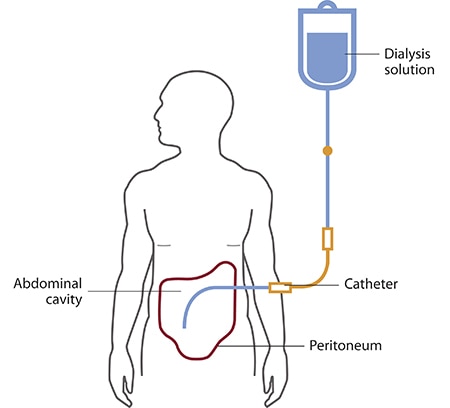
After a few hours, the solution and the wastes are drained out of your belly into the empty bag. You can throw abroad the used solution in a toilet or tub. And so, yous kickoff over with a fresh purse of dialysis solution. When the solution is fresh, it absorbs wastes speedily. Equally time passes, filtering slows. For this reason, y'all need to echo the procedure of elimination the used solution and refilling your abdomen with fresh solution four to six times every 24-hour interval. This procedure is called an commutation.
Y'all can do your exchanges during the twenty-four hours, or at nighttime using a machine that pumps the fluid in and out. For the best results, it is important that y'all perform all of your exchanges as prescribed. Dialysis can help y'all experience better and live longer, but it is not a cure for kidney failure.
How volition I experience when the dialysis solution is inside my abdomen?
You may feel the same as usual, or you may feel full or bloated. Your belly may enlarge a little. Some people need a larger size of wearable. Y'all shouldn't feel any pain. Near people look and feel normal despite a belly total of solution.
What are the types of peritoneal dialysis?
You lot tin can choose the type of peritoneal dialysis that best fits your life:
- continuous ambulatory peritoneal dialysis (CAPD)
- automated peritoneal dialysis
The main differences betwixt the ii types of peritoneal dialysis are
- the schedule of exchanges
- one uses a machine and the other is washed by hand
If one blazon of peritoneal dialysis doesn't accommodate you, talk with your dr. well-nigh trying the other blazon.
CAPD doesn't use a machine. You exercise the exchanges during the day by hand.
You can do exchanges by hand in whatever clean, well-lit identify. Each exchange takes virtually 30 to forty minutes. During an commutation, you can read, talk, picket telly, or sleep. With CAPD, yous keep the solution in your belly for iv to 6 hours or more. The time that the dialysis solution is in your abdomen is called the dwell fourth dimension. Usually, you modify the solution at least 4 times a day and sleep with solution in your belly at dark. You do not take to wake up at night to do an substitution.
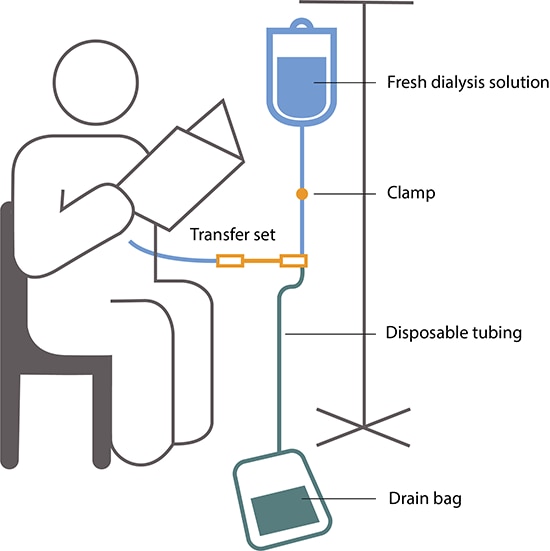
Automatic peritoneal dialysis. A machine does the exchanges while you sleep.
With automatic peritoneal dialysis, a automobile chosen a cycler fills and empties your belly three to five times during the dark. In the morn, yous begin the day with fresh solution in your belly. You may leave this solution in your abdomen all day or do 1 exchange in the middle of the afternoon without the machine. People sometimes call this handling continuous cycler-assisted peritoneal dialysis or CCPD.
Where can I do peritoneal dialysis?
You tin practise both CAPD and automated peritoneal dialysis in whatever clean, private place, including at home, at work, or when travelling.
Before you travel, yous can accept the manufacturer ship the supplies to where you're going so they'll be there when y'all get there. If you use automatic peritoneal dialysis, you'll have to carry your machine with you or program to do exchanges by hand while you're away from home.
How do I prepare for peritoneal dialysis?
Surgery to put in your catheter
Earlier your first treatment, you volition accept surgery to place a catheter into your abdomen. Planning your catheter placement at least 3 weeks before your commencement commutation can better handling success.
Although you can use the catheter for dialysis as soon equally information technology's in place, the catheter tends to work better when yous take 10 to xx days to heal before starting a full schedule of exchanges.
Your surgeon will make a small cutting, often below and a footling to the side of your belly button, and then guide the catheter through the slit into your peritoneal cavity. You'll receive general or local anesthesia, and you lot may need to stay overnight in the hospital. Notwithstanding, nearly people tin can go home after the process.
Y'all'll larn to care for the pare around the catheter, called the exit site, every bit function of your dialysis grooming.
Dialysis training
After grooming, most people can perform both types of peritoneal dialysis on their own. You'll piece of work with a dialysis nurse for one to 2 weeks to larn how to do exchanges and avoid infections. Near people bring a family unit member or friend to training. With a trained friend or family member, yous'll exist prepared in case you have a sick day and need aid with exchanges.
If you cull automated peritoneal dialysis, you lot'll acquire how to
- ready the cycler
- connect the bags of dialysis solution
- place the bleed tube
If y'all cull automated peritoneal dialysis, you besides demand to acquire how to do exchanges by paw in case of a power failure or if you demand an substitution during the solar day in add-on to dark automatic peritoneal dialysis.

How do I perform an substitution?
You'll need the following supplies:
- transfer set
- dialysis solution
- supplies to keep your exit site clean
If you choose automated peritoneal dialysis you lot'll need a cycler.
Your health care team will provide everything y'all need to begin peritoneal dialysis and assist you lot arrange to have supplies such as dialysis solution and surgical masks delivered to your home, usually one time a month. Careful mitt washing before and wearing a surgical mask over your nose and mouth while you connect your catheter to the transfer set can help preclude infection.
Use a transfer gear up to connect your catheter to the dialysis solution
A transfer ready is tubing that yous use to connect your catheter to the pocketbook of dialysis solution. When you beginning become your catheter, the section of tube that sticks out from your skin will have a secure cap on the finish to preclude infection. A connector under the cap will attach to any type of transfer gear up.
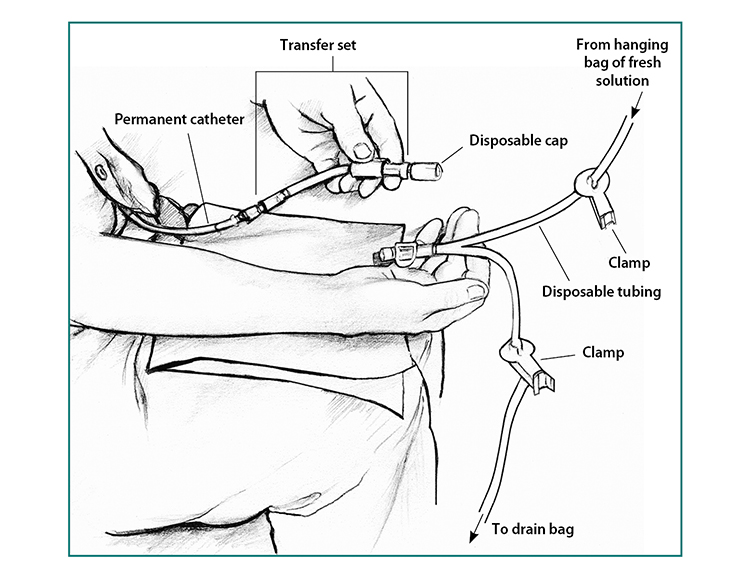
Between exchanges, y'all can keep your catheter and transfer gear up hidden inside your wear. At the outset of an substitution, you'll remove the disposable cap from the transfer set and connect the set to a tube that branches like the letter of the alphabet Y. 1 co-operative of the Y-tube connects to the drain bag, while the other connects to the pocketbook of fresh dialysis solution.
Use dialysis solution equally prescribed
Dialysis solution comes in 1.five-, 2-, 2.5-, or 3-liter bags. Solutions contain a saccharide called dextrose or a compound called icodextrin and minerals to pull the wastes and extra fluid from your blood into your belly. Different solutions have unlike strengths of dextrose or icodextrin. Your doctor will prescribe a formula that fits your needs.
You'll need a clean infinite to store your bags of solution and other supplies.
Doing an exchange by paw
- After you launder your hands and put on your surgical mask, drain the used dialysis solution from your belly into the drain bag. Near the end of the drain, you may feel a mild tugging awareness that tells you about of the fluid is gone. Close the transfer set.
- Warm each bag of solution to trunk temperature before utilize. Yous tin can utilize an electric blanket, or let the bag sit in a tub of warm water. Most solution bags come up in a protective outer wrapper, and y'all can warm them in a microwave. Don't microwave a bag of solution later you lot have removed it from its wrapper.
- Hang the new bag of solution on a pole and connect information technology to the tubing.
- Remove air from the tubes—allow a small amount of fresh, warm solution to menses directly from the new bag of solution into the bleed pocketbook.
- Clamp the tube that goes to the drain bag.
- Open or reconnect the transfer prepare, and refill your belly with fresh dialysis solution from the hanging bag.
Using a cycler for automatic peritoneal dialysis exchanges
In automatic peritoneal dialysis, y'all use a machine called a cycler to fill and drain your belly. Yous can program the cycler to requite yous dissimilar amounts of dialysis solution at different times.
Each evening, you gear up the auto to do three to five exchanges for you lot. You connect 3 to five bags of dialysis solution to tubing that goes into the cycler—one purse of solution for each exchange. The machine may have a special tube to connect the bag for the last exchange of the night.
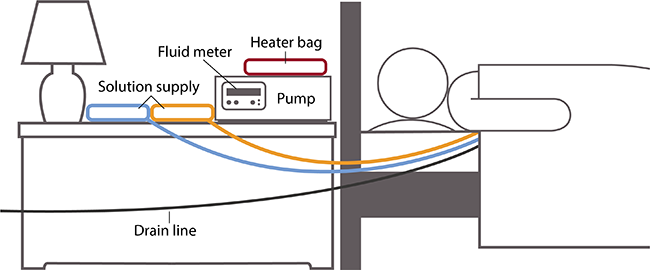
At the times you set up, the cycler
- releases a clamp and allows used solution to bleed out of your abdomen into the bleed line
- warms the fresh dialysis solution before it enters your body
- releases a clench to allow body-temperature solution to period into your abdomen
A fluid meter in the cycler measures and records how much solution the cycler removes. Some cyclers compare the amount that was put in with the amount that drains out. This feature lets you and your dr. know if the treatment is removing enough fluid from your body.
Some cyclers permit you lot to use a long drain line that drains directly into your toilet or bathtub. Others take a disposal container.
What changes volition I have to brand when I showtime peritoneal dialysis?
Daily routine
Your schedule will change as you lot work your dialysis exchanges into your routine. If y'all practice CAPD during the twenty-four hours, you take some control over when yous exercise the exchanges. Nevertheless, yous'll all the same need to end your normal activities and take about 30 minutes to perform an commutation. If y'all do automatic peritoneal dialysis, you'll have to prepare your cycler every night.
Physical action
You may need to limit some physical activities when your abdomen is total of dialysis solution. Yous may still be active and play sports, but y'all should hash out your activities with your health care squad.
Make changes to what you eat and beverage
If yous're on peritoneal dialysis, you may need to limit
- sodium
- phosphorus
- calories in your eating programme
Yous may also demand to
- watch how much liquid you drink and consume. Your dietitian will help you make up one's mind how much liquid you lot need to eat each twenty-four hour period.
- add protein to your diet because peritoneal dialysis removes poly peptide.
- choose foods with the right amount of potassium.
- take supplements made for people with kidney failure.
Eating the correct foods can help you feel ameliorate while you're on peritoneal dialysis. Talk with your dialysis eye'south dietitian to find a meal programme that works for you.
Medicines
Your doctor may make changes to the medicines y'all take.
Coping
Adjusting to the effects of kidney failure and the time you spend on dialysis can exist hard for both yous and your family. You may
- have less free energy
- need to give up some activities and duties at work or at home
A advisor or social worker can reply your questions and help you cope.
Take care of your exit site, supplies, and catheter to forestall infections
Your health care squad will show y'all how to keep your catheter clean to prevent infections. Here are some full general rules:
- Store your supplies in a cool, make clean, dry identify.
- Inspect each bag of solution for signs of contamination, such as cloudiness, before you utilise it.
- Detect a clean, dry, well-lit infinite to perform your exchanges.
- Wash your hands every time you need to handle your catheter.
- Clean your skin where your catheter enters your torso every day, as instructed past your health care team.
- Habiliment a surgical mask when performing exchanges.
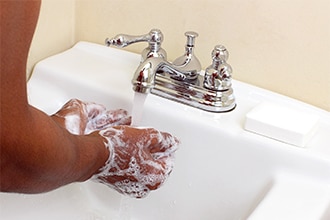
What are the possible problems from peritoneal dialysis?
Possible bug from peritoneal dialysis include infection, hernia, and weight gain.
Infection
One of the near serious bug related to peritoneal dialysis is infection. You can get an infection of the skin around your catheter exit site or you tin can develop peritonitis, an infection in the fluid in your belly. Bacteria can enter your body through your catheter equally you connect or disconnect it from the numberless.
Seek firsthand care if you have signs of infection
Signs of an go out site infection include redness, pus, swelling or jutting, and tenderness or pain at the exit site. Health care professionals treat infections at the go out site with antibiotics.
Peritonitis may crusade
- pain in the abdomen
- fever
- nausea or vomiting
- redness or pain around your catheter
- unusual colour or cloudiness in used dialysis solution
- the catheter cuff to push out from your trunk—the cuff is the part of the catheter that holds it in place
Health care professionals care for peritonitis with antibiotics. Antibiotics are added to the dialysis solution that you tin can usually take at dwelling house. Quick treatment may forbid boosted issues.
Hernia
A hernia is an area of weakness in your abdominal muscle.
Peritoneal dialysis increases your chance for a hernia for a couple of reasons. Beginning, y'all have an opening in your muscle for your catheter. Second, the weight of the dialysis solution within your abdomen puts pressure on your musculus. Hernias tin can occur nearly your belly push, near the exit site, or in your groin. If you take a swelling or new lump in your groin or abdomen, talk with your wellness care professional.
Weight gain from fluid and dextrose
The longer the dialysis solution remains in your belly, the more dextrose your body will absorb from the dialysis solution. This can cause weight proceeds over time.
Limit weight gain
With CAPD, you lot might have a problem with the long overnight dwell time. If your body absorbs likewise much fluid and dextrose overnight, you may be able to utilise a cycler to substitution your solution once while you sleep. This extra commutation will shorten your dwell time, keep your body from absorbing too much fluid and dextrose, and filter more wastes and actress fluid from your body.
With automated peritoneal dialysis, you may blot also much solution during the daytime substitution, which has a long dwell time. You may need an extra exchange in the midafternoon to keep your body from absorbing too much solution and to remove more wastes and extra fluid from your body.
Your dietitian tin can provide helpful guidance to reduce weight gain.
How will I know if my peritoneal dialysis is working?
To detect out if your dialysis exchanges are removing plenty wastes, you lot'll have a claret test and collect used dialysis solution once a month. If you lot're still urinating, you may need to collect urine.
These tests assistance your medico prescribe a dialysis schedule and dose to run into your wellness needs. If your dialysis schedule isn't removing enough wastes or your torso is absorbing too much dextrose, your doctor will make adjustments. Read about peritoneal dialysis dose and capability.
What Is The Name Of The Dialysis That Involves Using A Body Cavity As A Filter?,
Source: https://www.niddk.nih.gov/health-information/kidney-disease/kidney-failure/peritoneal-dialysis
Posted by: wilsonthisity93.blogspot.com


0 Response to "What Is The Name Of The Dialysis That Involves Using A Body Cavity As A Filter?"
Post a Comment